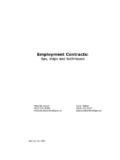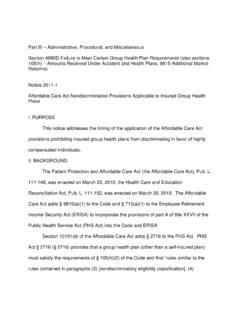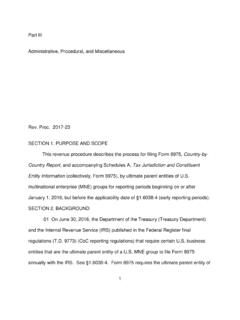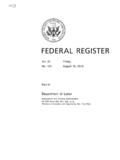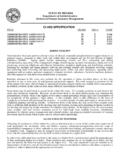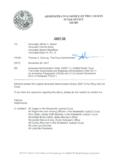Transcription of Procedural Fairness in Ontario - The Parameters of …
1 Procedural Fairness IN Ontario THE Parameters OF THE RIGHT TO BE HEARD: AN OVERVIEW submitted by: Janice Payne and Jessica Fullerton Nelligan O Brien Payne 66 Slater Street, Suite 1900 Ottawa, Ontario K1P 5H1 Tel: (613) 231-8245 Fax: 613-788-3655 E-mail: The Parameters of the Right to be Heard: An Overview 2 Nelligan O Brien Payne LLP TABLE OF CONTENTS I. Introduction II. The Content of Procedural Fairness 1. Introduction 2. Procedural Fairness and Administrative Bodies 3. Procedural Fairness and Context: Baker v. Canada (Minister of Citizenship Immigration) [1999] 817 III. Recent Case Law in Ontario on the Right to be Heard 1.
2 Introduction 2. Principles Emerging from Recent Case Law (a) Parties must be free to conduct their own case (b) Obligation to provide reasons (c) Obligation to consider alternative penalties (d) Opportunity to make oral submissions where decision turns on credibility (e) Reliance on a mistake of fact can amount to a breach of Procedural Fairness (f) Obligation to grant adjournments IV. Conclusion At its best, administrative justice is something like a cat quick, elegant, agile and independent-minded. 1 1 Judith McCormack, Nimble Justice: Revitalising Administrative Tribunals, (1995) 59 Saskatchewan Law Review at 385 (QL).
3 The Parameters of the Right to be Heard: An Overview 3 Nelligan O Brien Payne LLP I. Introduction From social benefits to correctional services, labour disputes to energy regulation, administrative boards and tribunals are everywhere. These public and quasi-public agencies administer, process, enforce, regulate, investigate, adjudicate and supervise. Individuals challenge them if they are refused a license and may seek them out if they are injured at work or discriminated against. Administrative bodies are an integral and important part of the public system. They are also at times inefficient, backlogged and under-funded. Regardless of the conditions under which they operate, administrative boards and tribunals executing a public duty are expected to do so in a procedurally fair manner.
4 The dictates of Procedural Fairness and in particular the right to be heard, have and continue to evolve in light of legislation, the Charter of Rights and Freedoms and the common law. This paper will explore and contextualize the developing scope of the right to be heard as it applies to tribunals and other administrative bodies in the province of Ontario by canvassing a sampling of recent judicial review cases in which the reviewing Court found a breach of the right to be heard by the administrative body. II. The Content of Procedural Fairness 1. Introduction The content of common law Procedural Fairness is generally divided into two separate categories. The first finds its origin in the Latin term audi alteram partem, meaning hear the other side or more commonly, the right to be heard.
5 As will become evident later in this paper, the right to be heard has been interpreted quite broadly, conferring on individuals a variety of Procedural entitlements. The second element of Procedural Fairness , which will not be addressed in this paper, is derived from the Latin term nemo judex in sua propria causa debet esse, essentially meaning that no one should be a judge in their own 2. Procedural Fairness and Administrative Bodies Procedural Fairness has come to be regarded as the bedrock of administrative law. 3 The prominence of this principle in the administrative context can be traced back to the Supreme Court s landmark decision in Nicholson v. Haldimond-Norfolk (Regional Municipality).4 Mr. Nicholson was a probationary police officer who was terminated.
6 His employer provided no reasons for terminating him but claimed that the Police Act allowed it to do so. The Court found that Mr. Nicholson had a common law right to be treated fairly. Mr. Nicholson should have been advised why his services were no longer needed and should also have been given the opportunity to respond. The effect of Nicholson was to impose on public authorities a duty to act fairly when 2 David J. Mullan. Essential of Canadian Law: Administrative Law (Toronto: Irwin Law, 2001) 232. 3 Ibid at 7. 4 [1979] 1 311 [Nicholson]. The Parameters of the Right to be Heard: An Overview 4 Nelligan O Brien Payne LLP making decisions.
7 The threshold for triggering the duty of Procedural Fairness was and remains quite low, requiring only that an individuals rights, privileges or interests be at 3. Procedural Fairness and Context: Baker v. Canada (Minister of Citizenship & Immigration) 2 817 6 A recent articulation of the elements of Procedural Fairness in the administrative law context was provided by the Supreme Court in Baker: The values underlying the duty of Procedural Fairness relate to the principle that the individual or individuals affected should have the opportunity to present their case fully and fairly, and have decision affecting their rights, interests, or privileges made using a fair, impartial and open process, appropriate to the statutory, institutional and social context of the The Court further emphasized that Procedural Fairness is flexible and entirely dependent on context.
8 In order to determine the degree of Procedural Fairness owed in a given in case, the court set out five factors to be considered: (1) the nature of the decision; (2) the nature of the statutory scheme; (3) the importance of the decision to the affected person; (4) the presence of any legitimate expectations; and (5) the choice of procedure made by the In many of the cases, including some of those set out below, one or two of these factors become dominant in determining the degree of Procedural Fairness . Further it is important to note that reviewing courts do not defer to administrative bodies on matters of Procedural Fairness . Where a breach is found, the decision will generally be rendered void by the reviewing Court and will require reconsideration by the administrative body.
9 III. Recent Case Law in Ontario on the Right to be Heard 1. Introduction Since Nicholson, the right to be heard has been held to include everything from the right to reasons and formal notice, to the right to an oral hearing. The Parameters of this principle continue to change. As the Baker decision underscores, Procedural entitlements are contingent on context. What is a breach of Procedural Fairness in one context may be a fair and acceptable practice in another. 5 Cardinal v. Kent Institution (Director), [1985] 2. 643 at para. 14. 6 [1999] 2. 817 [ Baker]. 7 Ibid. at para 21-28 8 Ibid. at para 28. The Parameters of the Right to be Heard: An Overview 5 Nelligan O Brien Payne LLP In order to provide a sense of where and in what circumstances these and other entitlements have been provided, this paper will canvass recent judicial review cases in Ontario in which the reviewing Court found a breach of the right to be heard.
10 2. Principles Emerging from Recent Case Law (a) Parties must be free to conduct their own case In some contexts, the right to be heard requires that an individual or group have the freedom to put forward their case in the manner in which they choose to. In the normal course of things, an administrative body would not tell a party what witnesses they are required to tender or provide statements for. In International Union of North America Local 183 v. Ontario (Human Rights Commission) 9 an employee and union steward, Mr. Tubbs, made comments during a union meeting about the treatment of minority union members, such as himself. Mr. Tubbs was black. On the night of the meeting, Mr. Tubbs comments were challenged by other Union members.

